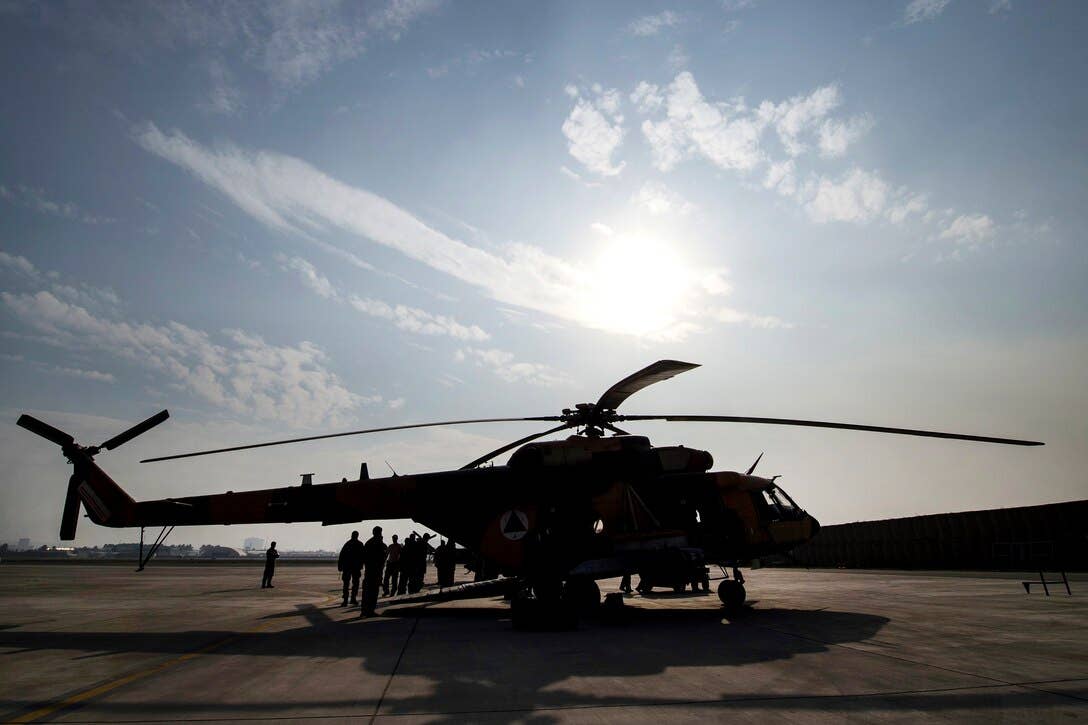White House Sending Mi-17 Helicopters, Radar To Ukraine
The latest round of aid increases the total the U.S. has provided Ukraine to $4.6 billion as the war approaches the 100-day mark.

An Afghan air force Mi-17 helicopter sits on the flight line before an aerial training mission with U.S. soldiers. [Courtesy: Department of Defense]
The U.S. is sending four Mi-17 helicopters, five counter-artillery radars, and two air surveillance radars to Ukraine, as part of a $700 million package of military aid that also includes tactical vehicles and anti-armor weapons, the White House announced.
The aid package announced Wednesday is the eleventh drawdown of equipment from U.S. defense inventories since Russia invaded Ukraine, and increases the total assistance from the U.S. to $4.6 billion since the onset of fighting on February 24.
Friday, June 3 marks the 100th day of the conflict that has resulted in at least 9,151 civilian casualties, including at least 4,169 deaths, the United Nations High Commissioner for Human Rights said Thursday.
"The people of Ukraine continue to inspire the world with their courage and resolve as they fight bravely to defend their country and their democracy against Russian aggression," President Joe Biden said Monday in announcing the aid. "The United States will stand with our Ukrainian partners and continue to provide Ukraine with weapons and equipment to defend itself."
As of June 1, the U.S. has committed the following in military aid to Ukraine, according to the Department of Defense:
- More than 1,400 Stinger anti-aircraft systems;
- Over 6,500 Javelin anti-armor systems;
- More than 20,000 other anti-armor systems
- Over 700 Switchblade tactical unmanned aerial systems
- 108 155mm Howitzers and over 220,000 155mm artillery rounds
- 90 Tactical Vehicles to tow 155mm Howitzers
- 15 Tactical Vehicles to recover equipment
- High Mobility Artillery Rocket Systems and ammunition
- 20 Mi-17 helicopters
- Hundreds of Armored High Mobility Multipurpose Wheeled Vehicles
- 200 M113 armored personnel carriers
- Over 7,000 small arms
- Over 50,000,000 rounds of small arms ammunition
- 75,000 sets of body armor and helmets;
- 121 Phoenix Ghost Tactical Unmanned Aerial Systems
- Laser-guided rocket systems
- Puma unmanned aerial systems
- Unmanned coastal defense vessels
- 22 counter-artillery radars
- Four counter-mortar radars
- Four air surveillance radars
- M18A1 Claymore anti-personnel munitions
- C-4 explosives and demolition equipment for obstacle clearing
- Tactical secure communications systems
- Night vision devices, thermal imagery systems, optics, and laser rangefinders
- Commercial satellite imagery services
- Explosive ordnance disposal protective gear
- Chemical, biological, radiological, and nuclear protective equipment
- Medical supplies to include first aid kits
- Electronic jamming equipment
- Field equipment and spare parts
News of the latest round of aid comes as the Biden Administration is shoring up plans to also sell four MQ-1C Gray Eagle combat drones to Ukraine, according to Reuters. The proposal, which is not yet a done deal, could be presented to Congress in the coming days.
"Generally the MQ-1C is a much larger aircraft with a max takeoff weight around three times that of the Bayraktar-TB2, with commensurate advantages in payload capacity, range, and endurance," drone expert Dan Gettinger with the Vertical Flight Society told Reuters.
The advanced combat drones have the capability to carry up to eight Hellfire missiles. Larger drones, like the U.S. Army’s General Atomics MQ-1 Gray Eagle unmanned aircraft systems and the U.S. Air Force’s variant, the MQ-1 Predator, could provide armed ISR capabilities with added features of automatic takeoff and landing.
“The effect they could yield is pretty substantial,” Doug Birkey, executive director, Mitchell Institute for Aerospace Studies, told FLYING in March. “It would be a big force multiplier.”

Sign-up for newsletters & special offers!
Get the latest FLYING stories & special offers delivered directly to your inbox






